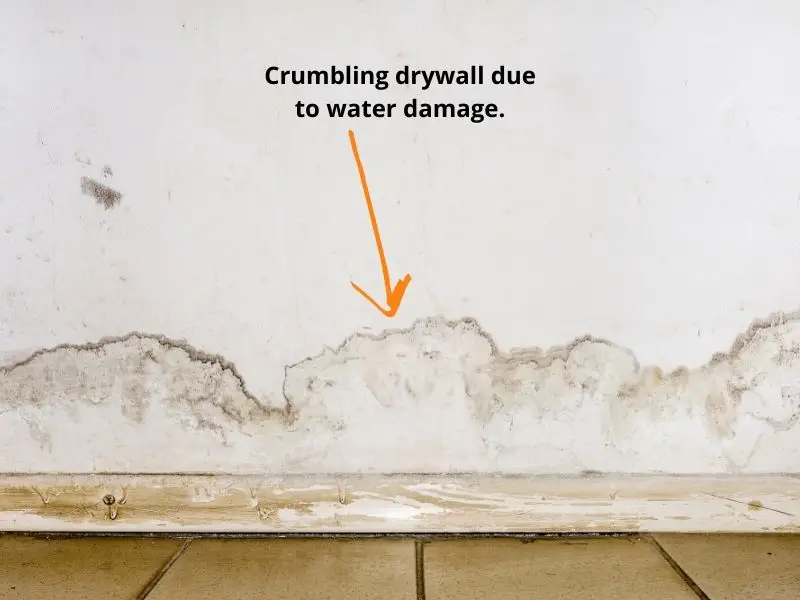Drywall Crumbling – Causes and Repair Options
Drywall, also commonly referred to as sheetrock, has a lifespan of 70 years when all conditions are perfect. However, you may start to notice defects such as cracks, holes, and bulges in your drywall walls way before this period. Crumbling is usually the worst problem. So, how do you fix crumbling drywall?
Remove and replace the damaged panel with a new one. If the damage is a small hole, apply a repair screen and patching compound to fix a crumbling drywall panel. Sand and paint the area to match the rest of the wall then fix the cause such as water leaks to prevent further drywall crumbling.
Why is my drywall crumbling?
Unless a large area of your wall is crumbling, you might only notice a crumble when drilling or around windows, doors, and other areas with pressure. The reasons behind this damage can be water damage or even a pest infestation.

Here are the reasons for drywall crumbling:
1. Water damage
Extreme water exposure is usually the main reason for drywall crumbling. If the panels are exposed to water or moisture in large amounts, or for a prolonged period, the gypsum will become saturated and will start to bulge, sag, and collapse.
Severe bulging of drywall sheets can start as a minor defect that can go away as the drywall dries up (after a flood clears, for example), but will eventually lead to crumbling of the walls.
Common causes of drywall water damage include the following:
- A constant pipe leak
- Prolonged high humidity
- Flooding
- Frequent water splashes on the walls
Water leaks on ceilings commonly lead to brown-stained rings that are very unsightly There may also be cracks in the ceilings or areas that are weakened by excessive moisture. The obvious fix for this is to remove the disintegrating drywall panels and replacing them with new boards.
2. Insect damage
Some insect pest infestations can start as minor issues but then develop into major construction problems. If your drywall is crumbling slowly, the reason could be that insects are eating away the sheetrock.
Insects such as termites, wood wasps, and powderpost beetles can infest your home and eat through sheetrock and leave it crumbling.
- Termites eat drywall to feed on the cellulose and paper that makes up the sheetrock bulk and cause damage. The damage is usually quick since termites are very hardworking, so a quick remedy is required as soon as you see signs of termite damage in sheetrock.
- Wood wasps create small holes in drywall in order to lay their eggs in the material. Many tiny holes weaken the strength and integrity of the drywall and can lead to crumbling over time.
- Powderpost beetles can also infest your home and start to eat through the drywall ceilings in order to get to the wood studs behind the panels. Their damage is not fast but can result in crumbling over time if not exterminated.
If you suspect your walls are crumbling because the drywall is being eaten away by insects, the best recourse is to exterminate the pests. More on this fix below.
3. Weak spot in drywall
Drywall panels can start to disintegrate if they have weak spots that can occur as a result of manufacturing defects or other damage. You’ll notice this when drilling through sheetrock or when driving new screws into the panels.
Crumbling can also occur in weak spots that were damaged by moisture, pests, or heavy impact. Sometimes, a DIY repair job might be done poorly leading to weakened areas in your drywall walls.
For example, if you tried to fill holes in drywall and didn’t allow the filler compound to dry up completely before adding subsequent coats, you’ll create weak spots that crumble easily when drilled. This usually occurs because the compound shrinks as it dries, leaving small spaces within the sheetrock, which affects its strength.
4. Gypsum core damage
Another reason for drywall crumbling is that too many repairs can affect the integrity of the original material. The worst is repair after water damage; even if the drywall is dried intensively, the drywall material cannot return to its original strength and shape.
After drying drywall following a flood or other water damage event, the gypsum core loses its integrity and solidity, and results in the crumbling of the walls easily.
If you’re buying a house with gypsum walls and ceilings, you might want to check for any major repairs that were done due to water damage. If they’re extensive, you should expect the drywall panels to weaken and crumble slowly by slowly over time.
How to Repair a Crumbling Drywall
Before you start repairing your walls, make sure you identify the cause of the problem and address it conclusively. In general, you can apply any one of the two fixes below (replacing the sheetrock, or, patching up the crumbled area) to repair your walls.
Here’s how you can repair crumbling drywall:
Replace the panel
To repair crumbling drywall, remove the damaged panel and replace it with a new panel. However, fix the underlying cause such as excess moisture by running a dehumidifier to prevent moisture from weakening the sheetrock.
Here’s a cool video to help you remove the crumbling drywall sheet and install a new one:
Run a dehumidifier in the house
If the crumbling is not too big, you might want to replace the damaged panel and then run a dehumidifier in the house to get rid of any moisture buildup in the remaining panels.
The point is to make sure that sheetrock remains dry enough and intact for the longest time possible. It also prevents mold from growing and penetrating into the gypsum.
Fix with patching compound
For small crumbling spots on drywall, the fix is to patch them up using a drywall repair screen and patching compound.
Here’s how to do it:
- Scrape around the crumbled area to remove any loose debris.
- Place the self-adhesive screen patch over the hole or dent.
- Cover the screen patch and the surrounding area with a patching compound.
- Allow the coat to dry completely.
- Apply a second coat, and allow it to dry.
- Sand the area with a fine grit sanding paper.
- Paint over the area to match the rest of the wall.
Pro tip: Do not apply too much patching compound over the hole to prevent a bulging appearance on the wall after you finish the repair.
